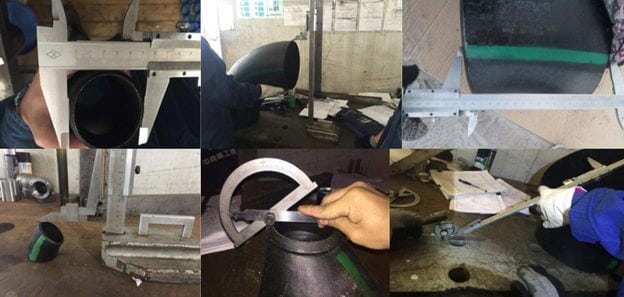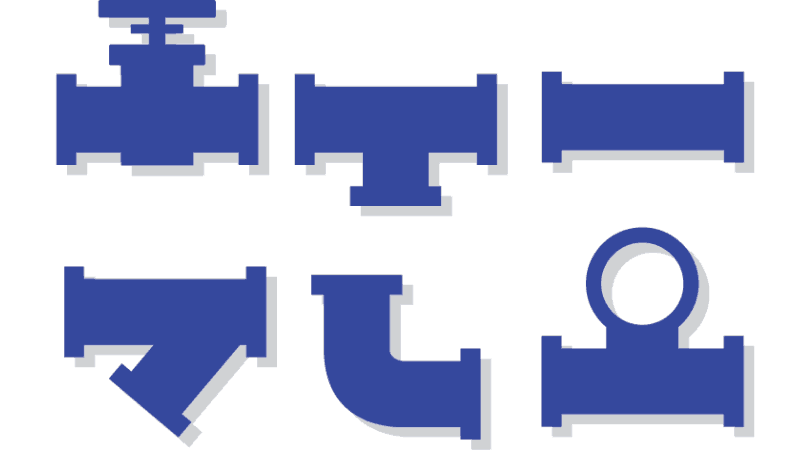Wrought Pipe Fitting dimensions are always in line with connecting pipe dimensions.
- Pipe Fittings are sized with respect to pipe size. In Nominal pipe size (NPS) & also as a Diameter nominal (DN)
- Thicknesses are marked in schedule no. Fittings generally have a higher thickness than the pipe to avoid any rejection due to thickness reduction during manufacturing. To avoid a mismatch of fittings ID to pipe ID, the manufacturer bevels the inside edge of fittings.
Forged Pipe Fittings are classified based on their pressure-temperature class
- Socket weld & Threaded end fittings are available from NPS 1/8” to 4” size
- Forged Fittings are available in the following pressure-temperature rating class
- 2000 (Only Threaded Fittings)
- 3000 & 6000 (for both types)
- 9000 (Only Socket Weld Fittings)
The standards used to check Dimensions of Pipe Fittings
- For Wrought Product (WP) Dimension is covered in
- ASME B16.9- which is standard for Factory-made Wrought Butt-welding Fittings for size NPS 1⁄₂ to NPS 48” and
- ASME B16.28- which is standard for Wrought Steel Butt-Welding Short Radius Elbows and Returns for size NPS 1⁄₂ to NPS 24”
- For Forged Fittings, Dimensions are covered in
- ASME B16.11- a standard for Forged Steel Fittings that covers Socket Welding and Threaded fittings
What to Check During Fittings Dimension Inspection?
Following to be confirmed during an inspection of pipe fitting dimensions
- Diameter
- Length
- Thickness schedule no
- Straightness & perpendicularity of the ends of the fitting
- Degree of elbows & bends
- And Concentricity of reducer
Check the following pages for the Pipe Fitting Dimensions and Tolerance
- Pipe Elbow Dimensions (Long Radius and Short Radius Elbow)
- Long Radius Return Dimensions (Long Radius Pipe Bends)
- Pipe Tee Dimensions
- Concentric Reducer Dimensions and Eccentric Reducer Dimensions
- Stub End Dimensions
- Pipe Coupling Dimensions
Pipe FIttings Quiz – Test yourself, Take This Quiz
Unlock New Skills with Our Best Selling Online Courses
Fitting Materials
Fittings are always connected with pipe; hence, the Chemical and Mechanical properties of these materials match with pipe material.
- Fittings are manufactured in different grades to match pipe materials such as carbon steel, alloy steel, stainless steel, and exotic materials such as titanium, copper alloy, etc.
- ASME B16.9 &16.28 provides a list of material used to manufacture wrought fittings
- ASME B16.34 Provides a list of materials used to manufacture forged fittings as per ASME B16.11
- ASME B16.9 is standard for – Factory-Made Wrought Buttwelding Fittings & ASME B16.28 is standard for – Butt-Welded Short Radius Elbows & Returns Bends
- ASME B16.11 is standard for – Forged steel socket welding & threaded fittings, which refers to another ASME standard for material which is standard for ASME B16.34 Flanged, Threaded, And Welding End Valves
The material grade shall be prefixed with WP if fittings are made as per ASME B16.9 & B16.28.
- Commonly used material grades for wrought fittings are listed here
- For Carbon Steel:- ASTM A234Gr.WPA/B, ASTM A420 Gr.WPL6
- For Alloy Steel:- ASTM A234 WP1 /WP5 /WP7 /WP9 /WP11 /WP12 /WP22
- And for Stainless Steel:- ASTM A403 WP304 /WP304L /WP304H /WP316 / WP316L/ WP321/ WP347
Are You Piping Components Master?




